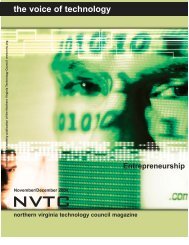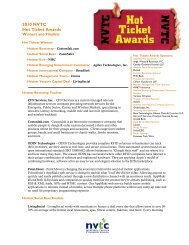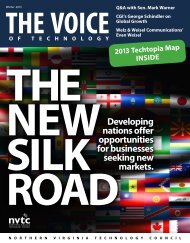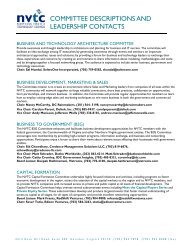Fall 2010 - Northern Virginia Technology Council
Fall 2010 - Northern Virginia Technology Council
Fall 2010 - Northern Virginia Technology Council
Create successful ePaper yourself
Turn your PDF publications into a flip-book with our unique Google optimized e-Paper software.
Q&A<br />
NVTC sat down with Sprint Chief Service and Information <strong>Technology</strong> Officer Bob Johnson, Verizon<br />
Wireless Maryland/DC/<strong>Virginia</strong> Region President Michael Maiorana, Comcast/NBC Universal<br />
Washington, D.C. President Kyle McSlarrow, and Cox Business <strong>Northern</strong> <strong>Virginia</strong> Vice President J.D.<br />
Myers for a discussion of rapid data growth, wireless technologies, business continuity, and how<br />
telecommunications tools are contributing to enterprise productivity and innovation.<br />
By Allison Gilmore<br />
PhotograPhs by DaviD KiDD<br />
nvtc What are some of the biggest trends shaping telecommunications<br />
right now?<br />
Bob Johnson: There are three overarching trends that are all<br />
somewhat interrelated. The first is a proliferation of both new sales<br />
and embedded customer purchases for PDAs and smart phones.<br />
The mix of those devices has increased from 30 percent a year ago<br />
to more than 50 percent today and will probably be close to 70<br />
percent by the end of next year. So that’s a huge shift.<br />
That trend leads to a couple of others. In particular, we have significant<br />
growth in mobile broadband data consumption because<br />
of the capabilities that these phones bring to bear and because of<br />
the high-speed processes that they have embedded in them. As a<br />
result, what you’re seeing is customers are really focused on the<br />
browsing capabilities and the applications that these handsets can<br />
now leverage because of the high-speed data networks and, frankly,<br />
the customization. The personalization trend is also coming to<br />
bear right now, as customers are looking for applications that they<br />
want to be able to use every day.<br />
Kyle McSlarrow: We see the same trends. Data consumption<br />
is going only one way, and that’s up. It’s amazing, the voracious<br />
appetite that residential and business America has for<br />
increased data.<br />
There are trends within the data too. Only a few years ago peerto-peer<br />
networks were an increasing part of data consumption on<br />
the network at the residential level, whereas over the last few years,<br />
increasingly it’s been less about peer-to-peer networks and more<br />
about streaming, including video. So we’re trying to pay attention<br />
to the trend lines within the data consumption so that we can<br />
meet our customers’ demand.<br />
J.D. Myers: In these discussions of rapid data growth, the big<br />
thing that we haven’t talked about yet specifically is wireless data<br />
growth. According to a Cisco white paper, wireless data will grow<br />
80 percent annually for the next six years in the U.S. For us, this<br />
represents the need for more capacity from cell towers to switching<br />
facilities — basically wireless backhaul.<br />
Our wholesale business experienced 30 percent revenue growth<br />
last year, which is tremendous, and wireless backhaul is the biggest<br />
contributor to this. This growth corresponds to the rapidly growing<br />
need for data and high-speed data connections by consumers,<br />
whether they’re browsing or using their PDAs for different things<br />
like GPS activities. That data requirement is really driving our<br />
business to continue to provide capacity for providers like Sprint.<br />
Also, data is driving other technologies that are becoming<br />
more prevalent in our business. For instance, we have the ability<br />
to provide wireless hot spots in prominent areas like hotels,<br />
restaurants and parks so that PDA customers can get onto Wi-Fi<br />
networks, allowing them to have more capacity for, and give priority<br />
to, voice calls by offloading the data demands in those highly<br />
populated areas. We’re offering solutions to allow carriers to do<br />
that too, which is huge from a data perspective.<br />
Mike Maiorana: Two of the biggest trends that I see in wireless<br />
communications are the rollout of fourth generation (4G LTE)<br />
wireless networking and the enabling of machine-to-machine<br />
(M2M) communications.<br />
The performance and capabilities of our 4G LTE network are<br />
allowing customers to do things that they never could do before<br />
in a wireless environment. In particular, we’re getting 10 times<br />
faster speeds than with a 3G network, which enable applications<br />
such as video sharing and surveillance, conferencing, streaming<br />
and high definition. And, LTE provides reduced latency and enhanced<br />
security, with robust and non-evasive mutual authentication,<br />
user identity confidentiality and integrity protection of all<br />
signaling messages.<br />
Further, M2M technology is really going to ignite the continued<br />
growth in the wireless industry. The new connectivity enabled<br />
by our 4G network is providing solutions like remote diagnostics,<br />
which allows large-scale apparatus and machinery to be constantly<br />
monitored for problems that can be repaired more quickly.<br />
M2M also allows cargo to be tracked and monitored through<br />
live streaming video and allows remote adjustments to be made<br />
<strong>Fall</strong> 2011 www.nvtc.org THE VOICE OF TECHNOLOGY 23

















